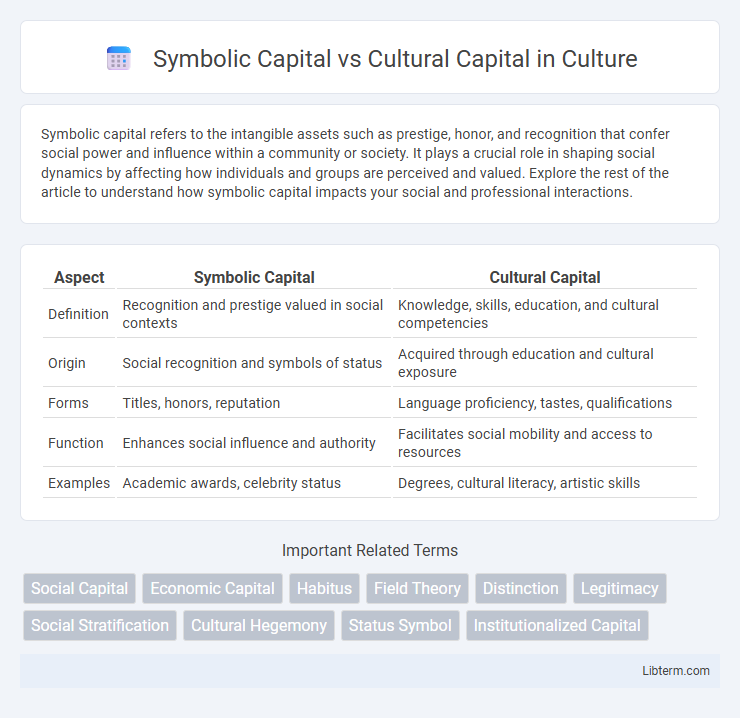Symbolic capital refers to the intangible assets such as prestige, honor, and recognition that confer social power and influence within a community or society. It plays a crucial role in shaping social dynamics by affecting how individuals and groups are perceived and valued. Explore the rest of the article to understand how symbolic capital impacts your social and professional interactions.
Table of Comparison
| Aspect | Symbolic Capital | Cultural Capital |
|---|---|---|
| Definition | Recognition and prestige valued in social contexts | Knowledge, skills, education, and cultural competencies |
| Origin | Social recognition and symbols of status | Acquired through education and cultural exposure |
| Forms | Titles, honors, reputation | Language proficiency, tastes, qualifications |
| Function | Enhances social influence and authority | Facilitates social mobility and access to resources |
| Examples | Academic awards, celebrity status | Degrees, cultural literacy, artistic skills |
Introduction to Symbolic and Cultural Capital
Symbolic capital refers to the resources available to an individual based on honor, prestige, or recognition within a social context, influencing power dynamics and social status. Cultural capital encompasses non-economic assets such as education, skills, knowledge, and cultural competencies that contribute to social mobility and influence. Both concepts, introduced by sociologist Pierre Bourdieu, highlight how intangible assets shape social hierarchies and individual opportunities.
Defining Symbolic Capital
Symbolic capital refers to the resources available to an individual or group based on honor, prestige, or recognition, which can be converted into social power and influence within a society. Unlike cultural capital, which encompasses knowledge, skills, and education, symbolic capital is primarily about perceived legitimacy and social esteem that confer authority and distinction. Pierre Bourdieu emphasizes symbolic capital as a form of power that operates through symbols and social codes, reinforcing the status and dominance of certain groups.
Understanding Cultural Capital
Cultural capital encompasses the non-financial social assets that influence an individual's social mobility, including education, intellect, style of speech, and dress. It shapes access to resources and power within a society by dictating social norms and prestige associated with knowledge and cultural competence. Understanding cultural capital is essential for analyzing how societal inequalities are reproduced through mechanisms beyond mere economic wealth.
Key Differences Between Symbolic and Cultural Capital
Symbolic capital refers to prestige, recognition, or social honor gained within a society, while cultural capital encompasses the knowledge, skills, education, and cultural competencies that enable social mobility. Key differences lie in their manifestations: symbolic capital is intangible and linked to reputation or status, whereas cultural capital is embodied in tangible assets like language proficiency, academic credentials, and cultural knowledge. Understanding these distinctions is crucial for analyzing social stratification and power dynamics in various sociological contexts.
Historical Development of Capital Concepts
The concepts of symbolic capital and cultural capital have evolved through Pierre Bourdieu's sociological theory, emphasizing how power and prestige operate within social structures. Cultural capital initially referred to non-economic assets such as education, skills, and knowledge that affect social mobility, while symbolic capital emerged to denote recognition and legitimacy that confer social authority. Historically, these forms of capital highlight the multifaceted ways individuals and groups accumulate and leverage social advantage beyond purely economic means.
Symbolic Capital in Social Hierarchies
Symbolic capital represents the prestige, recognition, and honor individuals accumulate within social hierarchies, functioning as a form of social currency that influences power dynamics and status. Unlike cultural capital, which encompasses knowledge, skills, and educational credentials, symbolic capital is primarily about perceived legitimacy and social esteem granted by others in a community or network. This form of capital plays a crucial role in maintaining and reproducing social stratification by legitimizing authority and unequal social positions through symbolic means.
Cultural Capital’s Role in Education and Society
Cultural capital encompasses knowledge, skills, education, and cultural competencies that individuals acquire, significantly influencing their social mobility and academic success. In education, cultural capital shapes students' access to resources, teacher expectations, and peer interactions, often perpetuating social inequalities through differential exposure to dominant cultural norms. Society values cultural capital as a marker of social status, affecting individuals' opportunities in employment, social networks, and overall societal participation.
Real-World Examples: Symbolic vs Cultural Capital
Symbolic capital manifests in real-world examples such as prestigious awards like the Nobel Prize, which confer social recognition and authority beyond economic wealth. Cultural capital is evident in educational qualifications, language proficiency, and art appreciation that enable social mobility and access to elite circles. For instance, a university degree (cultural capital) enhances employment opportunities, while the title "Sir" granted by a knighthood (symbolic capital) signifies honor and social status recognized by society.
Interplay and Overlap Between the Two Capitals
Symbolic capital and cultural capital frequently intersect, as symbolic capital transforms cultural assets like education, credentials, or style into recognized social prestige and influence. The interplay allows individuals to leverage cultural knowledge or practices not only for personal enrichment but also for gaining authority and status within social hierarchies. Overlapping functions emerge when cultural capital's embodied or institutionalized forms become symbols that confer legitimacy and power, reinforcing societal structures of distinction and privilege.
Implications for Social Mobility and Inequality
Symbolic capital, consisting of prestige and recognition, often translates into social advantages that can reinforce existing power structures, while cultural capital--embodied in education, skills, and cultural knowledge--enables individuals to navigate social institutions effectively. Disparities in access to both forms of capital contribute significantly to social mobility barriers, as those lacking symbolic or cultural capital face challenges in gaining upward economic or social status. This dynamic perpetuates social inequality by privileging groups with inherited cultural knowledge and esteemed social recognition, limiting opportunities for marginalized populations.
Symbolic Capital Infographic

 libterm.com
libterm.com